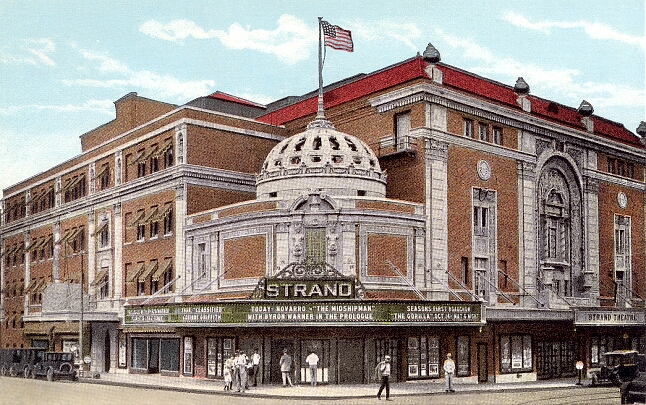| |
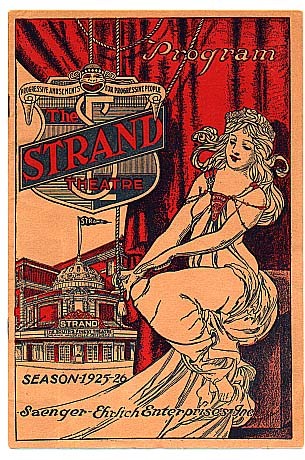
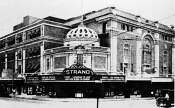
The Strand Theatre in Shreveport, in 1925. The marquee announces the Constance Talmadge movie Learning to Love.
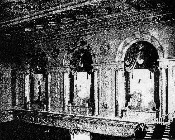
A photo taken before opening, showing the upper auditorium wall on house right.
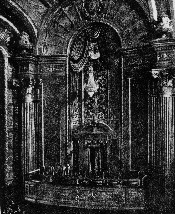
A photo taken before opening showing the house right organ grille, chandelier, & opera box.
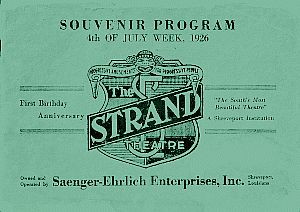
Take a look at the souvenir program for the Shreveport Strand's First
Anniversary in 1926.
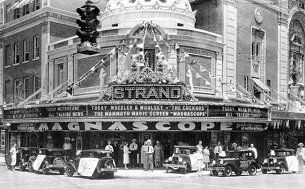
Magnascope, a movie presentation with a special projection lens & a larger-than usual screen, being used for a run of the movie musical The Cuckoos in 1930.
1925 photographs of the Strand from
the collection of Dr. Barry Henry.
|
|
Emile Weil's magnificent theatre constructed for
the Saenger-Ehrlich Company in the Saenger brothers' home
town remains in operation as a performing arts center,
& has been designated "The Official State
Theatre" of the state of Louisiana.
Much as the Saenger Company's 1917 Strand theatre in New Orleans represented a change in movie-going habits in the popular culture, the partnership with the Ehrlich Brothers to build the Strand in Shreveport was a representation of the preponderant shift in popular culture of theatrical entertainment from live shows to movies.
Shreveport's Grand Opera House, built in 1888 & operated by the Ehrlich Brothers, was the center of theatrical entertainment in Shreveport most of its existence. But as the Ehrlichs' lease on the building approached expiration & it became clear that it would not be renewed, the Ehrlichs needed a new large theatre.
At the same time, movies were gaining in ascendancy as theatrical entertainments, with the Saenger Theatre as the principal movie theatre in Shreveport. However, the trend in improving business in the exhibition industry was the opening of larger, more palatial theatres, & the Saenger company needed to erect such a theatre in Shreveport just as they had done in New Orleans.
The Ehrlich Brothers & the Saenger company did business together for some time, with the Ehrlichs leasing projection equipment from the Saengers for their own smaller movie theatres, so when the time came to assemble the financing for a new, large theatre for Shreveport the two companies collaborated again.
The Saenger company was more accustomed to assembling these deals than the Ehrlichs; the Saenger's usual method being creating companies to sell stock for the construction of each individual building, their own company participating with one or more entities in the stock ownership. In this case, the other major stockholder was the Ehrlich Brothers. In 1919, the Saenger-Ehrlich corporation bought the land for the new theatre.
The new building would be grander than the old Shreveport Grand Opera house, with better stage facilities as well. This meshed with the new, grander movie palace design: more ornate decoration, large orchestras, & large, efficient stage facilities for the live "prologues" presented before the films in an evening's movie program.
Architect Emile Weil's building showed the technical advances learned in the movie theatre architecture industry since the construction of the New Orleans Strand in 1917: in particular the exterior shows the better treatment for presentation of the exterior. Since a theatre is mostly a large, windowless auditorium requiring no windows on the facade, theatre construction had moved past the single-purpose type of building of the old Shreveport Grand Opera House to utilizing the front of the theatre building as commercial space to be leased for additional revenue. Although the front of the New Orleans Strand in 1917 functions the same way, the front of the Shreveport Strand in 1925 made much better decorative use of the building to signal its primary function as a theatre.
Julius Cahn's Official Theatrical Guide lists technical specifications of the Shreveport Grand Opera House, making it possible to compare them with those of the Grand Opera House's replacement, the Shreveport Strand. The Strand was a larger theatre, with a modern wider, lower proscenium opening. Also mentioned is that the Grand Opera House kept only 5 pieces in the pit orchestra.
| |
Grand Opera House,
Shreveport |
|
Strand Theatre,
Shreveport |
| Opened |
1888 |
|
1925 |
| Seating capacity |
1,153 |
|
2,250 |
| Proscenium width |
34 feet |
|
43 feet |
| Proscenium height |
37 feet |
|
27 feet |
| Distance footlights to back wall |
40 feet |
|
40 feet |
As a "combination house", the Strand was also fitted with all the up-to-date technical necessities of a movie palace: film & slide projectors, flown screen, & an orchestra pit to hold a large orchestra to accompany silent movies. Not the least was its theatre organ: a 2-manual, 13 rank organ manufactured by the Robert Morton organ company.
The Strand opened July 3, 1925 with the comic opera The Chocolate Soldier, a live production. The theatre was always intended to run movies on a regular basis though, & they started the very next week. Typically, if no live production was scheduled at the Strand, movies would appear first at the Strand & then move over to the smaller Saenger Theatre.
Stage productions grew less frequent, & the Strand's operation reflected the change in the theatrical industry of live productions such as vaudeville, stock theatre, and bus & truck shows quickly fading out & movies becoming the dominant local presentation.
Over the years, changes came to the Strand as they did most of the theatres. The Strand lost its chandeliers outside the auditorium, the opera boxes were removed in the chain-wide opera box removal during the installation of the larger VistaVision screens, & the exterior received a cladding of enamel panels.
By the 1970s, the Strand had arrived in the ownership of ABC Interstate Theatres, & was facing closure as a movie theatre. A non-profit organization, the Strand Theatre Corporation, was created to acquire the theatre. ABC Interstate donated the Strand to the Strand Theatre Corporation in 1977, & major restoration & renovation commenced to return the Strand to use as a performing arts center. Seating was re-spaced reducing the capacity to 1,636, the original exterior was restored, & the opera boxes & chandeliers were recreated as part of the extensive repairs & restoration.
|
|
